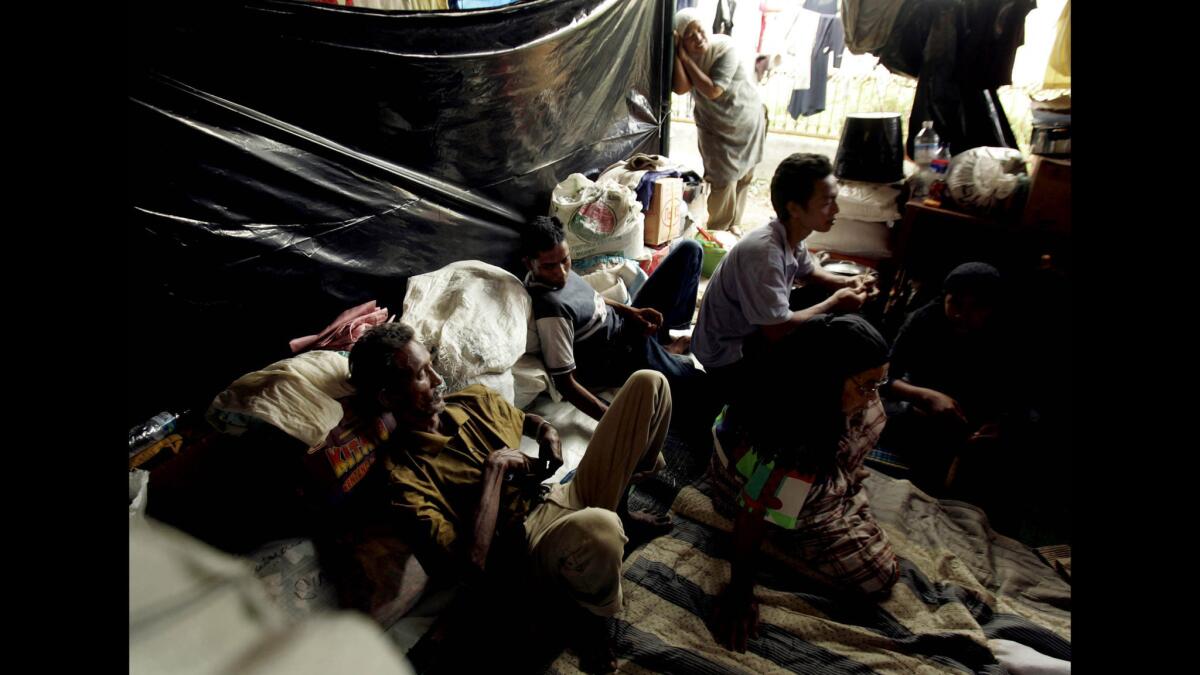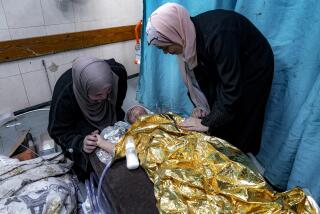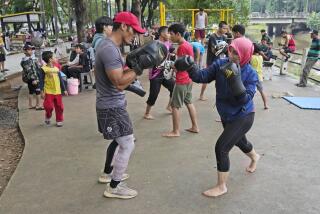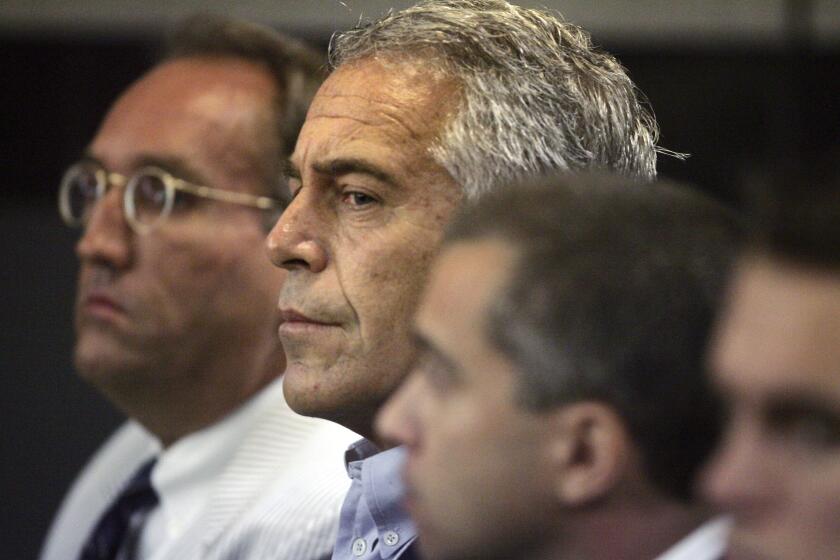Tsunami’s aftereffects take toll on Indonesian children

- Share via
MEULABOH, Indonesia — There was something about the schoolgirl’s face — her broad forehead, a familiar bump on the bridge of her nose.
Zainuddin went back home and pulled out an old photo of his niece. His heart racing, the 50-year-old called his sister. “I found your daughter,” he told her.
From that happenstance encounter six months ago, 14-year-old Raudhatul Jannah would be reunited with her family here in West Aceh, nearly a decade after she and her older brother were swept from their parents’ grasp by the great tsunami and given up as lost to the sea.
Jannah’s is one of the happier stories of the children whose lives were upended the morning of Dec. 26, 2004, when a monster earthquake shook the Indian Ocean floor, triggering giant waves that surged more than 21/2 miles inland on Indonesia’s Sumatra island.
All told, more than 230,000 people in Indonesia, Thailand, Sri Lanka, India and several other countries perished that day, half of them younger than 18, according to some estimates.
In hardest-hit Aceh province in Indonesia, most of the thousands of children who were reunited with their parents found them in the first few chaotic weeks, when relief agencies poured in and helped desperate families find missing children with photos posted in refugee camps and other places.
Ten years later, hundreds of schools have been rebuilt, thousands of teachers hired and a post-tsunami baby boom promises to fill the new classrooms for years to come.
Even so, few can say that life has returned to normal for the tsunami children.
In Aceh, the government estimates that as many as 33,000 children lost one or both parents. Many of them are still struggling to adjust. For a decade, they have lived in homes without a mother, father or sibling, or in families created by remarriages. Some lost their families altogether and were forced to live for at least a time on the streets or find refuge with benevolent strangers.
No one can forget the diaster for very long because of subsequent earthquakes here. Some children are seized with fear even when it rains.
“I never go back to the beach,” says Iqbal, who like many Indonesians goes by a single name. For the lanky young man, now 18 and with a thin mustache, the “thick and black waters” remain as vivid as ever in his mind, as do the details of that day when his parents were separated and he lost one of his two sisters.
“My mom was shopping in the market, and my dad was waiting for her on a motorbike,” Iqbal says. “I was at home watching TV, a Japanese cartoon. There was a big earthquake and suddenly people were shouting, ‘The seawater is rising! It’s rising.’” Iqbal and his sisters and older brother ran out of the house together, he says, but one of the girls “didn’t make it.” He is now living at home with a brother, sister and their father, who works as a street merchant selling ginger.
At Junior High School No. 9 in Banda Aceh, about 10% of the current students lost their mothers or fathers, says the headmaster, Abdullah. “Many [tsunami] children were toddlers when their fathers got remarried because they had young children and it was hard to raise the family on their own,” he explains. Abdullah, who doubles as the school’s counselor, says remarriages have caused stress and behavioral problems in some children.
“Now they have grown up and realize that this is not their real mom,” he says. “Some of them keep skipping classes or don’t come to school at all.”
Junior High No. 9 was one of about 1,500 schools in Aceh flattened by torrents of water so powerful that a 2,600-ton barge was lifted and dropped nearly two miles from shore. The tsunami arrived on Sunday morning when school was out, but the earthquake and tsunami claimed the lives of 45,000 students and 1,820 teachers in Aceh. At least eight teachers and an unknown number of students at Junior High No. 9 were lost.
With aid from an Indonesian bank, the public school was rebuilt and opened in August 2006. It now has 325 students in the seventh to ninth grades, compared with 500 before the tsunami. Tiasma, a 34-year veteran teacher at No. 9, says the students today score lower in tests and seem more distracted and sad than those she taught a decade earlier. Economically, she says, more families are struggling to buy books for their children.
Yet in a number of ways, Aceh children are better off than before the tsunami. Scores of international relief groups have helped improve health and hygiene standards. Vaccination rates for children are much higher; and significantly more are enrolled in early childhood education programs. Aceh’s mental-health system also has developed, although the World Health Organization says funds are drying up.
Rina Agustina was 4 when her mother carried her out of their house and ran until she tripped on a rope tied to a boat that was carried by the waves. The next thing Rina remembers was a group of guys lifting her from the water and taking her upstairs in a house, and then later to another village.
Rina would never see her mother and older sister again. And it was a full month before she would be reunited with her father, Mustafa Kamal, who found her after looking through photos posted at a Save the Children office in Banda Aceh. Kamal couldn’t tell for sure whether it was his daughter; the girl in the picture had mud on her face. He couldn’t see whether she had Rina’s dimples. And none of the children’s photos on the board had names on them, to guard against potential kidnapping.
Aidil Syahputra, a relief worker at the nonprofit organization, says he asked Kamal questions about his daughter’s personality and hobbies. Syahputra then took a snapshot of Kamal and later that day displayed his picture along with those of four other men on a table before Rina. “Which one is your father?” Syahputra asked the 4-year-old. Immediately she pointed to Kamal.
Since then, Kamal has remarried. He has not had steady work, but Rina is doing well in school and seems to be a happy teenager. Wearing a bright red shirt and big smile, she talks about how she loves to ride her bike and wants to be a lawyer. Her stepmother, Yanti, says Rina doesn’t have nightmares or exhibit other signs of trauma, except one: When there’s an earthquake or when it rains hard, Rina is paralyzed by fear.
“She freezes,” Yanti says. “If she’s sitting down, she can’t get up by herself. Her fear isn’t normal.”
For Jannah, the young girl reunited with her parents after nearly a decade, the last few months have been a whirlwind. After her uncle spotted her standing at a cellphone kiosk in June, Jannah had a tearful reunion with her parents within days. By August, she was back home in Meulaboh, at the very spot where she and her still-missing brother, Arif, had been swept away by the waves and presumed dead. Before summer’s end, Jannah’s family announced that Arif had also been found, as a result of the extensive publicity.
Jannah’s mother, father, uncles and other relatives in Meulaboh and elsewhere are eager to recount details of the story: how Jannah and Arif clung to a plank of wood after slipping from their parents’ grasp; how both children were rescued by a fisherman who ended up adopting just Jannah; how Arif was mostly homeless.
Jamaliah, Jannah’s mother, says the trauma of the last decade took a toll on 17-year-old Arif. He had gone no further than the third grade. Jannah is behind too. At 14, she has yet to finish fifth grade.
Still, Jamaliah says, “We’re very happy now. Our family feels complete.”
More to Read
Sign up for Essential California
The most important California stories and recommendations in your inbox every morning.
You may occasionally receive promotional content from the Los Angeles Times.














